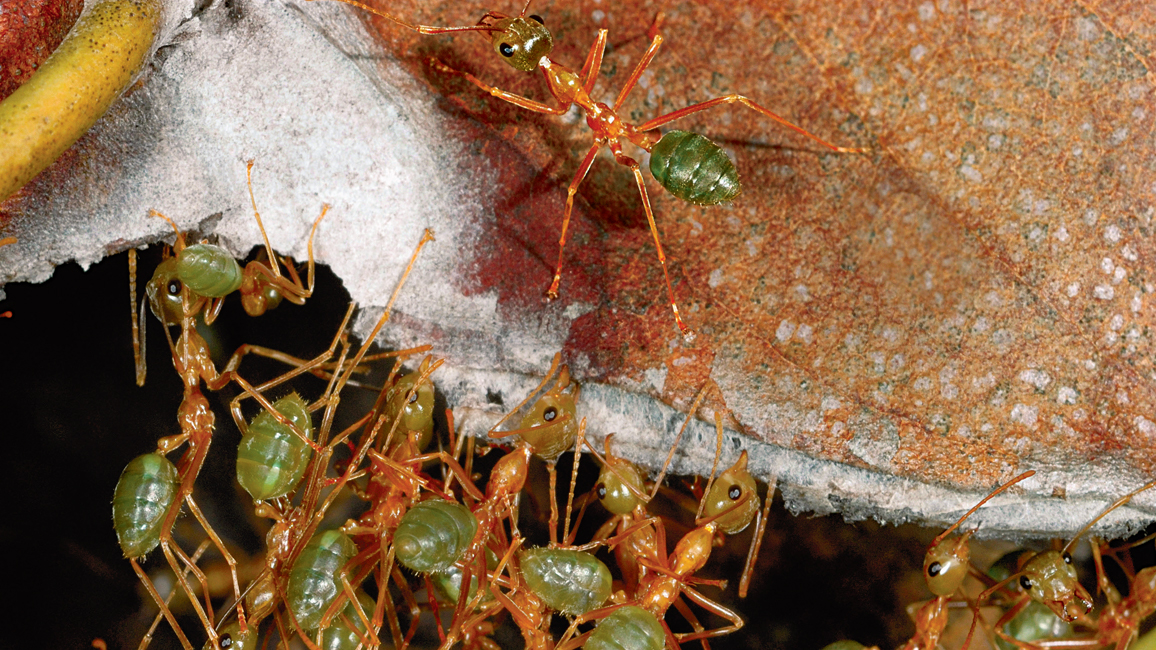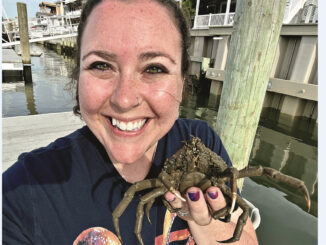
Treetop Weavers
By Gerry Bishop; photos from Minden PicturesHave you ever heard of living sewing machines? That’s what these ants are!
Climb any tree, anywhere, and you’ll probably find ants near the top. Some are just looking around for food, while others may have made tiny nests in tree holes, under loose bark, and in other hideaways. But weaver ants rule the treetops they occupy. They use the trees’ leaves to make lots of nests where they raise hundreds of thousands of young ants.
Although there are more than 12,000 known species of ants, only two of those are weaver ants. They live in Asia, Africa, and Australia, so you may never have seen them in action.
Grab, Tug, Sew!
Every weaver ant nest begins the same way. A few ants grab on to the edge of a leaf with their powerful jaws. At the same time, they hold on to the edge of a nearby leaf with the claws on their legs. Then they begin to pull the two leaves together. Soon dozens or even hundreds of ants may join the team.
When the leaf edges are close together, another team of workers shows up. These ants are carrying special “tools” in their jaws. The tools aren’t hammers or screwdrivers or anything else you may think of. They’re little white larvae (LAR-vee)–young ants that the workers bring from a nearby nest.
Each tool-carrying ant holds the head of its larva against one of the leaf edges. Then the ant taps the larva with its two antennas. The tapping causes the larva to squirt a thin strand of sticky silk out from under its head. As the silk comes out, the ant swings the larva across to the other leaf edge. Back and forth it goes, over and over again, to “stitch” the leaves together.
Nearby, other weaver ants are pulling on more leaves and stitching them all together. In less than a day, the ants have made a nest about the size of a football!
Making More Ants
The new nest may be just one of many that the ants have made. A large colony, or group of ants, may have more than 100 nests scattered throughout the treetops–with more than 500,000 ants living in them. It’s sort of like a whole city of ants up there!
Inside the main nest, a huge weaver ant–the queen–is busy pumping out eggs. Much smaller worker ants care for the eggs and the larvae that hatch from them. The larvae then go into a resting stage as pupae (PYOO-pee). This is the stage during which they gradually change into adult weaver ants.
The eggs and larvae keep coming, and soon the main nest gets too crowded. So the workers begin carrying new eggs to one of the other nests they’ve made. There, workers care for the young ants, just as they do in the main nest.
On Guard!
Raising babies is just one big job in an ant colony. Another is protecting the young–and the queen–from harm. So, all around the outside of the nests, the biggest and strongest ant workers in the colony are on guard. If an enemy threatens the nests, the guards rear up and rap their bodies against the leaf they’re standing on. When the other ants feel the vibrations, they quickly get the message: “Danger is near!” The guards also give off powerful scents that spread the same warning. Soon hundreds of ants are ready for battle.
The invader may be a hungry spider, a raiding party of larger ants, a lizard, a bird, or even a person. (In some places, people collect weaver ants for food.) And when the invader comes too close, the guards attack fiercely. (The ant expert who took most of the photos in this story was bitten hundreds of times!) Using their sharp and powerful jaws, the ants tear at the invader. They also can spray a powerful acid that burns the enemy’s skin.
Meanwhile, inside the nest where the queen is living, workers also have gotten the message. Quickly, they pile up over the queen to protect her.
Sneak Attacks
Weaver ants have been around for millions of years. And during that time, some of their enemies have come up with some nasty tricks.
A certain kind of jumping spider, for example, can fool the weaver ants with its smell, which is just like a weaver ant’s. So the ants think the spider is another one of their nestmates. (Scent, rather than sight, rules in an ant colony.) As the spider approaches, the ants don’t even notice it. Instead of attacking the spider, they just go about their business. The spider then can snatch one of the larvae and run off with its dinner.
On the Hunt
Every minute of every day, there are thousands of weaver ants out on the prowl, looking for good things to eat. When one of the ants discovers prey, it gives off a scent that says to all the other ants: “Food! Here! Now!”
And what may become food for weaver ants? Mostly insects. But it can be just about anything they can gang up on and carry back to their nests: a snail, a spider, a scorpion, or even a baby bird or bat!
Back inside the nest, the workers grab the prey on all sides and begin pulling in opposite directions. Rip! Tear! As bits and pieces come off the prey, the ants carry them away to feed to the rest of the colony.
Harvesting Honeydew
While the biggest and strongest workers are out hunting prey, the smaller workers are also busy gathering food.
The food they seek comes from small insects called scale. These blob-like creatures cling to tree twigs and suck out the tree’s sap. But rather than kill and eat the scale, the ants protect them from harm. Why? The scale insects give off a sweet liquid called honeydew. And the ants love it!
The workers swallow some of the honeydew and carry it back to their nests. Then they “throw up” the sweet liquid and feed it to the larvae.
So, everywhere you look, the colony of weaver ants is hard at work: making new nests (and new ants), fighting off enemies, and gathering food. It’s the weaver-ant way!
“Treetop Weavers” originally appeared in the June/July 2015 issue of Ranger Rick magazine.
(Click on each image above for a closer view of the story.)



















